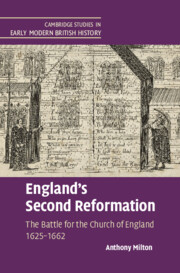Book contents
- England’s Second Reformation
- Cambridge Studies in Early Modern British History
- England’s Second Reformation
- Copyright page
- Dedication
- Contents
- Acknowledgements
- Abbreviations
- Introduction
- Chapter 1 An Unresolved Reformation
- Chapter 2 Situating the Laudian Reformation
- Chapter 3 Responses to the Laudian Reformation
- Chapter 4 The Abortive Reformation, 1640–1642
- Chapter 5 The End of Episcopalian Reformation
- Chapter 6 Reformation by Negotiation
- Chapter 7 The Westminster Reformation and the Parliamentarian Church of England
- Chapter 8 The Royalist Church of England, 1642–1649
- Chapter 9 Alternative Reformations, 1649–1653
- Chapter 10 The Cromwellian Church
- Chapter 11 Episcopalian Royalism in the 1650s
- Chapter 12 Failed Reformations, 1659–1661
- Chapter 13 The End of Comprehensive Reformation and the Caroline Settlement
- Conclusion
- Index
Chapter 4 - The Abortive Reformation, 1640–1642
Published online by Cambridge University Press: 05 October 2021
- England’s Second Reformation
- Cambridge Studies in Early Modern British History
- England’s Second Reformation
- Copyright page
- Dedication
- Contents
- Acknowledgements
- Abbreviations
- Introduction
- Chapter 1 An Unresolved Reformation
- Chapter 2 Situating the Laudian Reformation
- Chapter 3 Responses to the Laudian Reformation
- Chapter 4 The Abortive Reformation, 1640–1642
- Chapter 5 The End of Episcopalian Reformation
- Chapter 6 Reformation by Negotiation
- Chapter 7 The Westminster Reformation and the Parliamentarian Church of England
- Chapter 8 The Royalist Church of England, 1642–1649
- Chapter 9 Alternative Reformations, 1649–1653
- Chapter 10 The Cromwellian Church
- Chapter 11 Episcopalian Royalism in the 1650s
- Chapter 12 Failed Reformations, 1659–1661
- Chapter 13 The End of Comprehensive Reformation and the Caroline Settlement
- Conclusion
- Index
Summary
Chapter 4 focuses on the ‘abortive reformation’ – a series of measures proposed and in some cases implemented in the years 1640-41 which aimed at the reform rather than the abolition of episcopacy and the Prayer Book. It initially surveys how Laudian ideas and policies were systematically rejected by senior clergy, not least by the advisory sub-committee under Bishop Williams established by the House of Lords committee investigating religious innovations. De-Laudianization in itself re-formulated the Church of England, but was combined with a readiness to contemplate significant reforms of church government, liturgy and ceremonies. The chapter analyses these reforms proposed by a range of protagonists including the Williams Committee, which addressed some of the objections raised in the puritan Ministers’ Petition and Remonstrance. Episcopal reforms – most notably in the shape of ‘reduced episcopacy’ – show conformists ready to contemplate significant changes to the established church. It is argued that Parliament played a key role in all the envisaged reforms and was already seizing de facto power over the existing ecclesiastical system. Despite the failure of these reforms to be implemented, both sides at the outbreak of war were theoretically committed to this ‘abortive reformation’ in their competition for the ideological middle ground.
Keywords
- Type
- Chapter
- Information
- England's Second ReformationThe Battle for the Church of England 1625–1662, pp. 101 - 143Publisher: Cambridge University PressPrint publication year: 2021

